Introduction
The initial steps of Total Quality Management (TQM) started in the 1920s with the Hawthorne experiments, which showed how participation could increase employee productivity. Later in 1930, Walter Shewhart settled the approaches for quality control by statistical analysis. In 1950 several quality gurus made their contribution to the expansion of criteria regarding Quality; Edward Deming is considered the pioneer of TQM. His contribution to Japanese industries teaching tools and methodologies for statistical analysis and quality control generated significant productivity and a level of quality increase; this is considered the origin of TQM. During the same decade, Philip Crosby launched zero-defect thinking through many organizations. Later, TQM transformed into the philosophy of a systematic and holistic approach to managing quality (Westcott, 2013). Nowadays, similar concepts have arisen; one is Business Excellence (BE), which promotes a similar philosophy to TQM. BE has been transitioned to be pursued through the Business Excellence Models (BEM).
In this paper, the European Foundation for Quality Management (EFQM) model 2020 is reviewed based on a bibliometric analysis to identify its relationship with the TQM approach, giving place to the primary objective and research question of this paper: What is the relationship between EFQM model 2020 and TQM approach?
As a secondary objective, once the relationship is understood, the attributes of the EFQM model and the TQM approach were compared, and based on the findings through the literature review, it was identified which one is more suitable to drive BE.
The structure of this paper initially shows a literature review (section 2) for the main topics of study Business Excellence, EFQM model, and TQM, including the concept of bibliometric analysis. Method (section 3) describes the input and process of the bibliometric analysis, while Results (section 4) describes the detailed findings on the existing relationship. In order to summarize findings, on Conclusions (section 5), the authors give their interpretation of the research question to further end this paper with the Acknowledges (section 6) and References (section 7).
1. Literature review
For this section, relevant papers from the Scopus database were selected, mainly the ones that approached the three main concepts in the study: BE, EFQM model & TQM. Additionally, one essential input for the literature review is the EFQM model 2020, as well as some relevant books, in addition to the findings of the Scopus database.
1.1. Business Excellence (BE)
BE looks to develop, consolidate, and strengthen the organizational management system and processes to generate value and continuously improve performance. BE is much more than having a quality system in place. BE aims to achieve higher business results by extending the excellence framework to the different areas of the organization, including leadership, strategy, customer focus, information management, people, and processes (Mann et al., 2012, p. 1).
BE focuses on five main leverages to develop the organization:
- Process design & improvement.
- Shared strategic direction.
- Performance measurement & feedback.
- Knowledge capture & leverage.
- Leadership & management of change.
The robust presence of the above five elements maximizes the benefit and decreases the likelihood of weak starts and unfocused efforts (James, 2020).
The definition of BE can be interpreted as a philosophy but also as guidelines for organizations to achieve excellence in strategy, business practices, results, and stakeholder relationships, focusing on getting outstanding performance (Kim et al., 2010).
The concept of BE became very popular with the introduction of BEMs. It is common to identify that some BEMs consider an evaluation and awarding method inside their structure. It is part of the benchmarking BE promotes.
Several BEMs have been proposed and adopted by thousands of organizations worldwide. Its major components include the BE criteria or categories integrated into a holistic framework with both business enablers and business results reinforced by core values. Additionally, the BEMs incorporate an assessment methodology that can support the organization’s self-assessment or the application to national BE Awards. (Fonseca, 2021, p. 3).
For most BEMs, national or international bodies have supported the current BEMs as a foundation for awards such as the European Foundation for Quality Management Excellence Award (Dahlgaard et al., 2013).
The critical factors for quality and excellence management are those that condition success in the design, implementation, development, and improvement of the management system of the organizations (Jabnoun, Sedrani, 2005). Critical factors that are systematically repeated in research are leadership, training, teamwork, worker involvement, people management, data analysis, supplier management, strategic planning, process management, product design, benchmarking, continuous improvement, and empowerment (Ebrahimpour, Sila, 2005), all of the above factors are covered in the EFQM model.
As mentioned, BE main five elements have been adopted by the different BEMs (such as the EFQM Model, Malcolm Baldrige, and Japan Quality Award Criteria, among others). In this paper, we explore its relation to the EFQM Model. The EFQM model has been one of the most popular excellence models since its introduction in 1991; it has been recognized as a holistic approach that supports organizations of any business or industry in managing change and improving their performance. It is flexible enough to be adopted by different size organizations.
A comparison with the 2020 Malcolm Baldrige Performance Excellence Award and the 2015 Canadian Excellence Innovation Wellness national award shows that neither of those excellence models goes further than the neoliberal capitalist approach to corporate organizations. Malcolm Baldrige sees the ecosystem as a business ecosystem, a network of suppliers, partners, customers, and competitors, a framework for business growth, and a new resource potential for making better value proposals. The Canadian Excellence model is more conservative in different criteria: only people’s well-being is a special feature in the model, emphasizing organizational and mental health policies. In contrast to these, the EFQM model 2020 has a vision for outstanding organizations looking for organizations not only to be excellent in leadership, operations, and results, they should demonstrate an outstanding role in their ecosystems (Hervaine, 2020).
1.2. Total Quality Management (TQM)
TQM is usually defined as a management system for a customer-focused organization that involves all associates in processes regarding continuous improvement. It has a set of elements or enablers to integrate the quality mindset and way of working into the philosophy and processes of the organization. Some enablers are strategy definition, decision taking via data-driven analysis, and effective communication concepts and channels. TQM structure is based on the following principles:
1. Customer-focused.
2. Total employee involvement.
3. Process-centered.
4. Integrated system.
5. Strategic and systematic approach.
6. Continual improvement.
7. Fact-based decision-making.
8. Communications.
Edward Deming stated that TQM supports companies in improving their quality and productivity results by following the proposed practices. He developed Deming’s 14 Points on Quality Management, or the Deming Model of Quality Management, which consist of the following:
- Create constancy of purpose for improving products and services.
- Adopt the new philosophy.
- Cease dependence on inspection to achieve quality.
- End the practice of awarding business on price alone; instead, minimize total cost by working with a single supplier.
- Improve constantly and forever every process for planning, production, and service.
- Institute training on the job.
- Adopt and institute leadership.
- Drive out fear.
- Break down barriers between staff areas.
- Eliminate slogans, exhortations, and targets for the workforce.
- Eliminate numerical quotas for the workforce and numerical goals for management.
- Remove barriers that rob people of pride in the quality and eliminate the annual rating or merit system.
- Institute a vigorous program of education and self-improvement for everyone.
- Put everybody in the company to work accomplishing the transformation.
An evident relation is observed between the 8 TQM principles and Deming’s 14 Points on Quality Management, in which Deming seems to define a step-by-step approach for introducing the 8 TQM principles (Westcott, 2013).
1.3. EFQM Model
The EFQM model offers a framework that analyses the interactions between what an organization does and the results that it can achieve regarding its clients, staff, society, and key stakeholders. This framework has a rational and methodical structure of analysis, which supports organizations to perform a deep reflection of their management and perform a comparison with other organizations (benchmarking); it also supports the knowledge or guiding elements for the strategy definition and deployment, also supports identifying its key results and needed resources to achieve it. The EFQM model has an assessment tool used to measure the framework maturity of its nine criteria, which serve as the base for identifying strengths and opportunities for improvement. (Calvo, Picon, Ruiz, Cauzo, 2015. P3).
The EFQM 2020 model is based on the existing interaction between an organization’s purpose and Strategy and how it is transformed into execution and results. It is aligned with the United Nations Sustainable Development Goals (UNSDGs), which are very important for the business sector in the key and smaller donor countries and provide a comparative advantage to US firms, local governments, solidarity, and charity organizations (Hervaine, 2020).
The EFQM model represents a philosophy of comprehensive organizational management that fits the demands of the current environment, enabling management to focus on stakeholders’ satisfaction and achieve better performance (Paraschi et al., 2019).
The EFQM 2020 model is grouped into three dimensions, Direction, which focuses on why the organization exists; execution which aims to show how the processes are developed; and Results, which answer what the organization is getting as an outcome.
It is supported by 23 criteria distributed into Direction and Execution, plus 2 Results Criteria, which have 112 guidance points, and a reflection tool called RADAR, which evaluates each dimension in aspects such as Approach, Deployment, and Assessment & Refinement (used in Direction and Execution dimensions) and Relevance & Usability and Performance for the Results Criterion. The EFQM model also considers the Megatrends which influence the Ecosystem where companies develop their activities (Fonseca, 2021).
Since its beginning, the EFQM model has offered a blueprint for organizations to create a continuous improvement and innovation culture. The model is co-created by a core team of specialists from different businesses and academia through surveys, workshops, and face-to-face meetings with different types of organizations. The latest update of the model up to the issuing of this paper is the version from 2020 (EFQM, 2020).
The latest update to the model shows as focus topics the seven following criteria:
Criterion 1: Purpose, Vision & Strategy.
Criterion 2: Organizational culture & leadership.
Criterion 3: Engaging stakeholders.
Criterion 4: Creating sustainable value.
Criterion 5: Driving performance & transformation.
Criterion 6: Stakeholder perceptions.
Criterion 7: Strategic & operational performance.
EFQM Model (2020) uses the RADAR to evaluate the maturity of each criterion. RADAR is the shortening to explain the logic of the reflection tool used to support organizations to manage better the way of working and evaluate its strengths and potential improvement areas. It primarily assesses an organization’s success in achieving its objectives and whether the organization is on the right track to attaining excellence (Dahlgaard et al., 2013).
The RADAR logic states that an organization needs to (EFQM, 2020):
- Determine the Results it aims to achieve as part of its Strategy.
- Have in place an approach that will deliver the required result, both now and in the future.
- Deploy this approach appropriately.
- Assess and Refine the deployed approach to learn and improve.
Figure 1
EFQM Model. Source: EFQM Model 2020
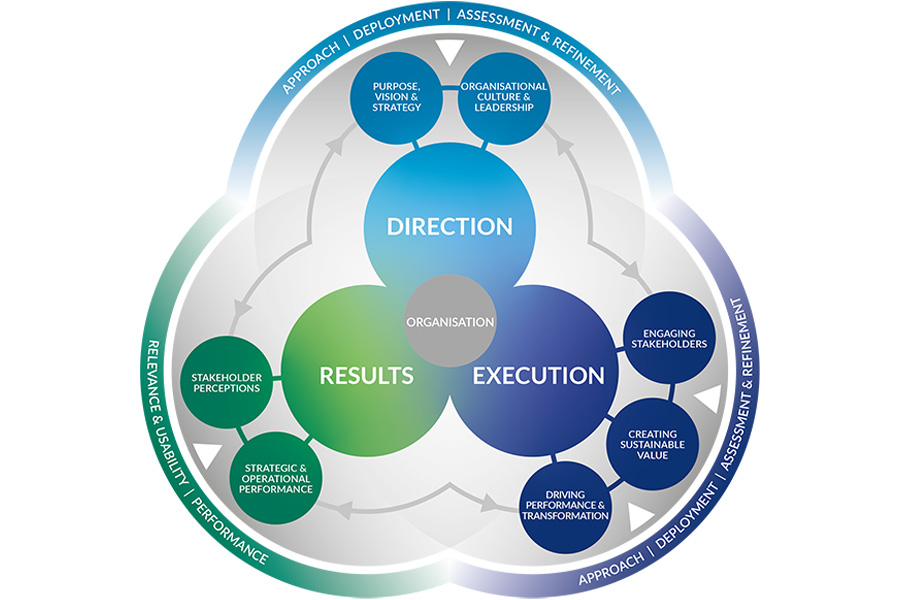
As a holistic approach and following the principles of BE, the EFQM Model is aligned and supports adherence to the 17 UNSDGs. The description of its practices and the essence of the model is considered to take care and overlook for the society, environment, and people’s well-being, per its publication (EFQM ORG, 2020), the EFQM Model is aligned to the 17 UNSDGs:
- No poverty.
- Zero hunger.
- Good health and well-being.
- Quality education.
- Gender equality.
- Clean water and sanitation.
- Affordable and clean energy.
- Decent work and economic growth.
- Industry, innovation, and infrastructure.
- Reducing inequality.
- Sustainable cities and communities.
- Responsible consumption and production.
- Climate action.
- Life below water.
- Life on land.
- Peace, justice, and strong institutions.
- Partnerships for the goals.
The EFQM Model, as a holistic approach, considers a broad group of external relations that the organization interacts with, not only focusing on the final customer, but it also focuses on different levels of stakeholders and other external influences; this interaction is defined as Ecosystem. EFQM model describes “a fundamental principle of an ecosystem is interdependence, i.e., something that happens in one part of the system may affect other parts within the system. In the context of an organization, many external factors affect how it operates, but over which it has no control. These can include government policy, the economic and societal make-up within its region and neighborhoods, its communities’ prevailing religious and cultural expectations, demand sustainability, and available financing” (EFQM, 2020, p.58).
Figure 2
EFQM 2020 Ecosystem Map. Source: EFQM Model 2020
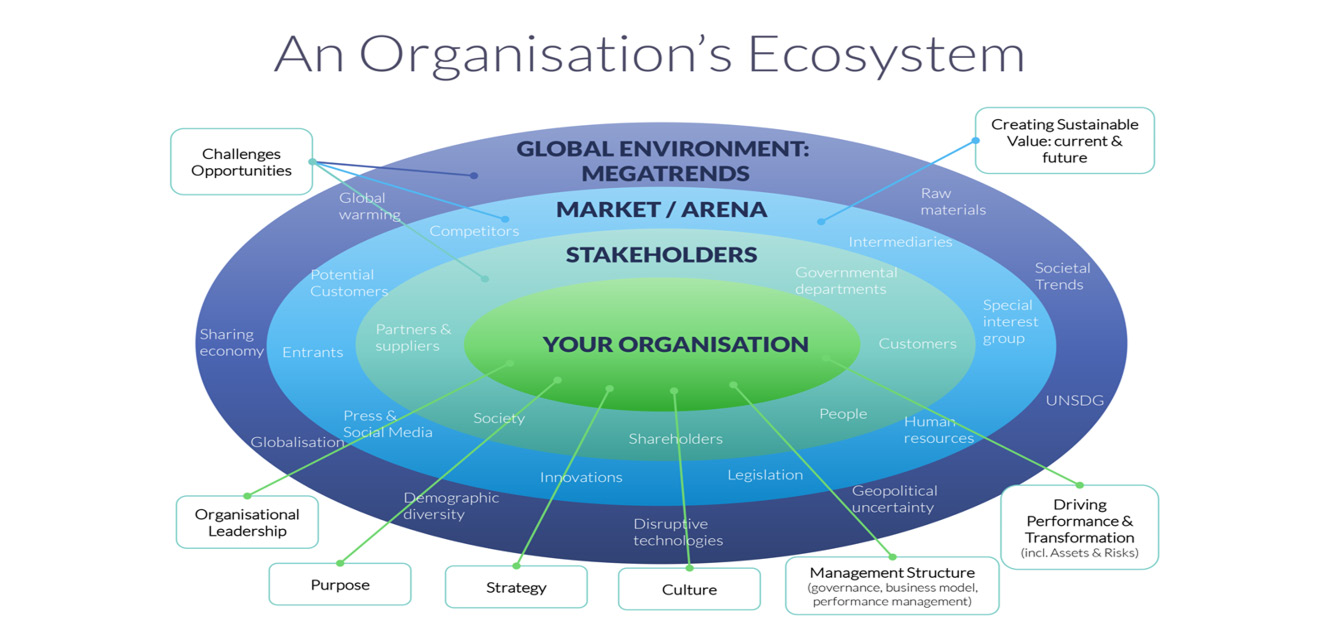
Also, the EFQM model considers the ongoing streams on the ecosystem in order to be prepared for the future, and these are called Megatrends, defined by the EFQM (2020, p.57) as “topics that are expected/predicted to be global influences in the coming years. These are the topics that, regardless of size, reach or Private/Public sector status, an organization should heed to remain relevant”. Some Megatrends identified by the EFQM are collaborative economy, self-managing systems, scarce resources, skill shortages & automation, increasing regulation, environmental crises, demographic diversity, and geopolitical uncertainty (EFQM, 2020).
The EFQM model 2020 is based on the methodology of the Golden Circle (why, how, and what) by Simon Sinek (2009), adhering to the philosophy that the heart of an organization should be its Purpose. The development of its processes and operations should be born from the inside (Purpose) to the outside, not backward. The relation is as follows: the Direction perspective responds to Why an organization exists. Criterions included are Purpose, vision, strategy, organizational culture, and leadership. The Execution perspective includes criteria that respond to How the organization develops and execute its processes. The criteria are stakeholder involvement, creating sustainable value, driving performance, and transformation. The Results perspective includes criteria focusing on What the organization obtains through the Execution criteria. In this last perspective, the criterions included are stakeholders’ perceptions; strategic and operational performance (Fonseca, 2021).
The following picture shows the Golden Circle representation. As mentioned above, its elements relate to the EFQM model perspectives, from inside to outside.
Figure 3
The Golden Circle. Source: Simon Sinek
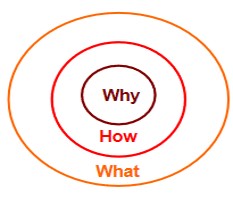
Source: Simon Sinek
In order to understand the EFQM model criteria, below is a description of its main focus elements, called sub-criteria (EFQM, 2020).
Direction.
Criterion 1: Purpose, vision & strategy.
1.1. Define purpose & vision.
1.2. Identify & understand stakeholders’ needs.
1.3. Understand the ecosystem, its own capabilities & major challenges.
1.4. Develop a strategy.
1.5. Design & implement a governance & performance management system.
Criterion 2: Organizational culture & leadership.
2.1. Steer the organization’s culture & nurture values.
2.2. Create the conditions for realizing change.
2.3. Enable creativity & innovation.
2.4. Unite behind & engage in purpose, vision & strategy.
Execution.
Criterion 3: Engaging stakeholders.
3.1. Customers: Build sustainable relationships.
3.2. People: attract, engage, develop & retain.
3.3. Business & governing stakeholders – secure & sustain ongoing support.
3.4. Society: Contribute to development, well-being & prosperity.
3.5. Partners & suppliers: Build relationships & ensure support for creating sustainable value.
Criterion 4: Creating sustainable value.
4.1. Design the value & how it is created.
4.2. Communicate & sell the value.
4.3. Deliver the value.
4.4. Define & implement the overall experience.
Criterion 5: Driving performance & transformation.
5.1. Drive performance & manage risk.
5.2. Transform the organization for the future.
5.3. Drive innovation & utilize technology.
5.4. Leverage data, information & knowledge.
5.5. Manage assets & resources.
Results.
Criterion 6: Stakeholder perceptions.
6.1 Customer perception results.
6.2 People perception results.
6.3 Business & governing stakeholders perception results.
6.4 Society perception results.
6.5 Partners & suppliers perception results.
Criterion 7: Strategic & operational performance.
Achievements in delivering purpose, strategy & creating sustainable value.
Fulfillment of key stakeholder expectations.
Economic & financial performance.
Achievement in driving performance & transformation.
Predictive measures for the future.
1.4. Bibliometric analysis
According to Donthu, Kumar, Mukherjee, Pandey & Lim (2021), “Bibliometric analysis is a popular and rigorous method for exploring and analyzing large volumes of scientific data. It enables us to unpack the evolutionary nuances of a specific field while shedding light on the emerging areas in that field. Nevertheless, its application in business research is relatively new and, in many instances, underdeveloped. The bibliometric methodology encapsulates the application of quantitative techniques (i.e., bibliometric analysis—e.g., citation analysis) on bibliometric data (e.g., units of publication and citation) (Broadus, 1987; Pritchard, 1969).”
This paper aims to perform a bibliometric analysis to identify the relationship between the TQM and EFQM models and evaluate which could better support the pursuit of BE in actual times.
2. Method
This bibliometric analysis is based on the information obtained from the Scopus database in October 2021. The database for the articles analyzed has two layers to identify research density for the two main concepts involved. EFQM is the top keyword (323 articles), and Business Excellence (385 articles) is the secondary keyword. The reason for using Scopus is that it offers broader coverage of research literature compared to other research databases, it includes a more significant number of journals and conference proceedings from various disciplines, including the sciences, social sciences, humanities, and more, and as the EFQM model is used by different types of organizations diversification of sources was significant for this study (Pranckute, 2021).
The research period starts from publications from 1990 up to 2021. Once databases were individually generated, a manual crosscheck was performed to include articles not shown in the EFQM database (EFQM as a keyword). However, it included EFQM Word in its abstract in the Business Excellence database. A total of 39 articles were detected under this condition, and after removing the repeated ones (9 repeated), 30 articles were manually added to the final database, which contains 353 articles.
In order to perform a detailed analysis of TQM content related to EFQM and Business Excellence, a third layer of analysis was added, filtering articles that contained TQM as a keyword on their title or abstract, resulting in 40 articles that were reviewed for the theoretical purpose of the content of this paper.
The bibliometric study is shown in the following two levels:
1st level: Includes Primary keyword EFQM model and secondary keyword Business Excellence regarding EFQM.
2nd level: Identification of the presence of TQM keyword regarding 1st level database.
A Boolean logic approach was used to generate the database. The initial level of the database was constructed using the logical operator “AND” between the terms “EFQM” and “Business Excellence.” For the second database, Boolean logic was not used; the second database was obtained by generating a filtered search for the word TQM in the first database.
The methodology applied for this paper is supported by content analysis (textual and visual reading) of the 40 articles mentioned, including the content of the EFQM 2020 model, relevant business textbooks, and websites were also considered to get a broader view and updated revision of literature.
In order to interpret the databases, a bibliometric analysis was done. The selected documents out of the layered databases were analyzed utilizing the statistical software R. It includes a library called Bibliometrix which contains an application named Biblioshiny; it is a web interface application that shows the representation of the Bibliometric results in graphical state, figures, or tables. It uses several tools to correlate data and to show affinity diagrams. (Aria & Cuccurullo 2017).
As a result of the application of the method proposed, the following infographics related to the annual scientific production were generated: annual scientific production, thematic evolution, most relevant sources, most local cited sources, source growth, most relevant authors, corresponding author’s country and collaboration network by countries. Infographics generated are presented and detailed in the next section.
3. Results
The results are divided into two parts. As mentioned in the method section, both levels of databases were analyzed, compared, and concluded to identify similarities, trends, and relations.
Regarding figures 4 and 5, it can be observed that EFQM model publications have grown through the years. A significant increase was observed from 2010 to 2012. It can be attributed to the update of the framework of the model in 2010 but also to the internalization of the model.
Figure 4
Annual scientific production, database level 1 (EFQM & Business Excellence). Source: Bibliometric analysis out of R software
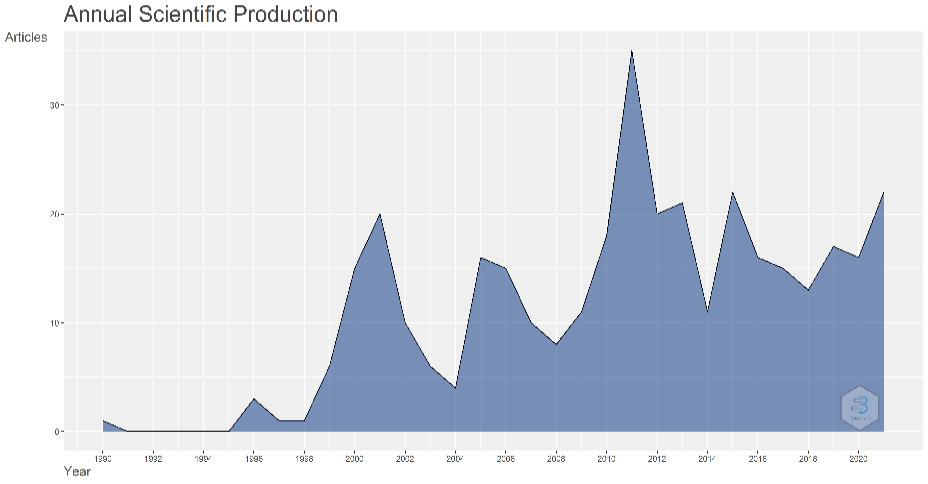
Figure 5
Annual scientific production, database level 2 (TQM in regard to EFQM & Business Excellence). Source: Bibliometric analysis out of R software
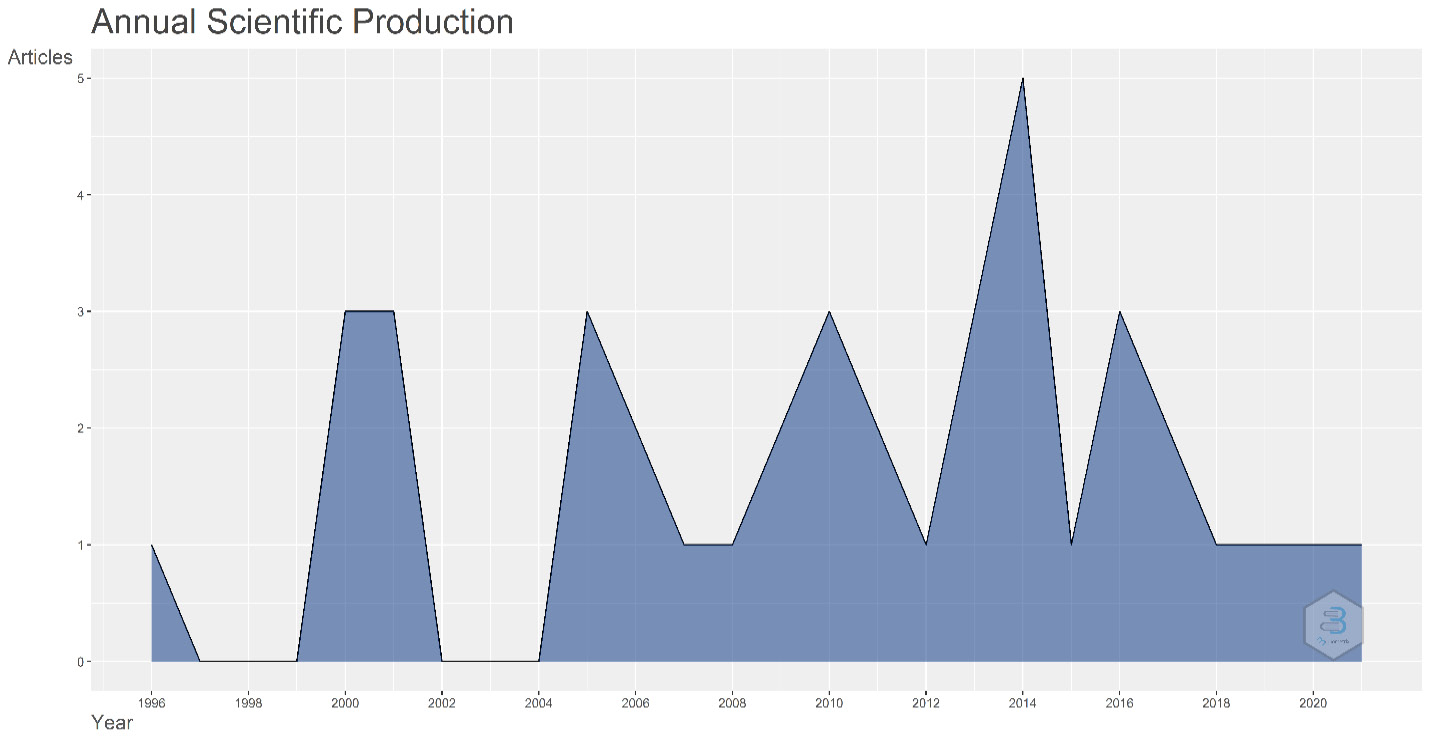
Focusing on TQM research concerning EFQM, it can be seen in Figure 5 that there has been growth through the years but no clear tendency for an increase. It is worth noting that a transition is taking place, where TQM is gradually replaced by the more comprehensive term “Business Excellence.”. To support this statement, see Figure 6, which relates the terms & definitions through the years to observe the evolution of the usage of the terms.
As Mann (2014, p.3) states, “Business Excellence Models (BEMs) were first called Total Quality Management models. Today they are usually referred to as Business Excellence Models. This term helps to communicate the importance of excellence in all aspects of a business, not only product and process quality.”
Figure 6
Thematic evolution, database level 1 (EFQM & Business Excellence). Source: Bibliometric analysis out of R software

Figures 7 and 8 compare the sources which more activity regarding the subjects analyzed, by far the Total Quality Management and Business Excellence source is the top 1 in the study about EFQM model articles publications, also the same top 1 is observed for database label 2, which relates the TQM to EFQM and Business excellence.
Figure 7
Most relevant sources, database level 1 (EFQM & Business Excellence). Source: Bibliometric analysis out of R software
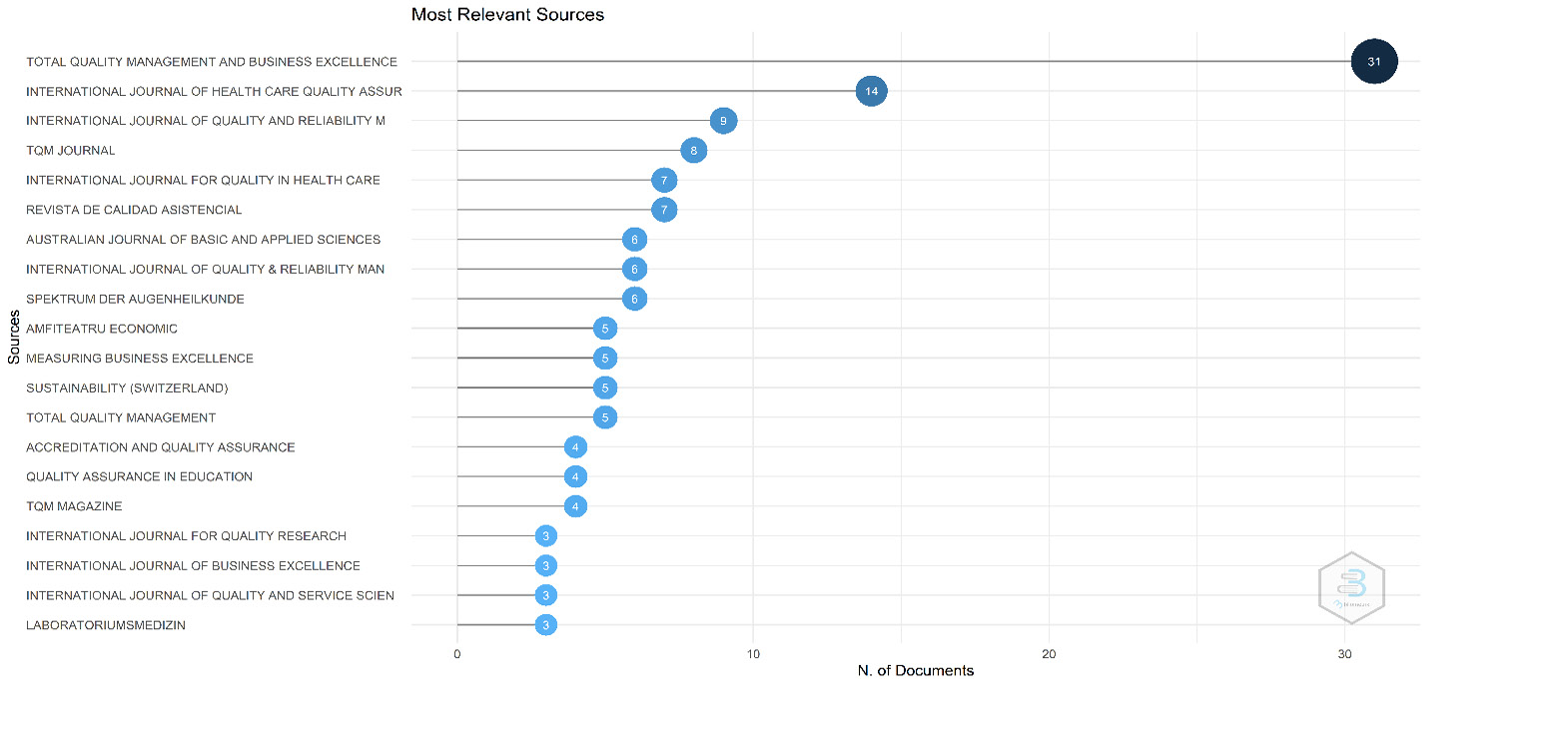
Figure 8
Most relevant sources, database level 2 (TQM in regard to EFQM & Business Excellence). Source: Bibliometric analysis out of R software
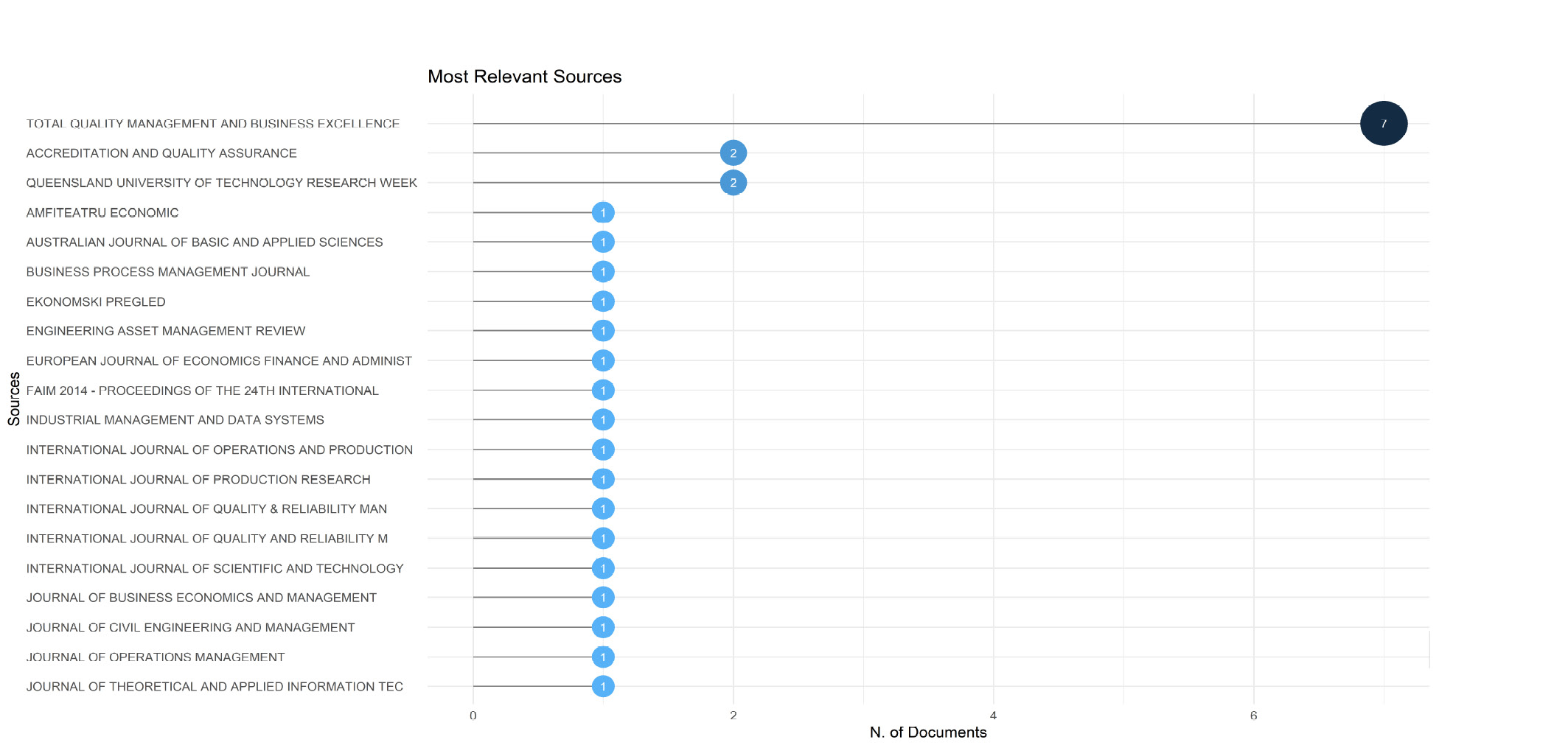
An interesting fact is the following, Total Quality Management and Business Excellence source has a significant number of documents published, but there are more cited sources. As we see below in Figures 9 and 10, the most locally cited source is the Total Quality Management source, which only has five documents, 84% less than the top 1 in documents published. The same leverage occurs for database levels 1 and 2.
Figure 9
Most local cited sources, database level 1 (EFQM & Business Excellence). Source: Bibliometric analysis out of R software
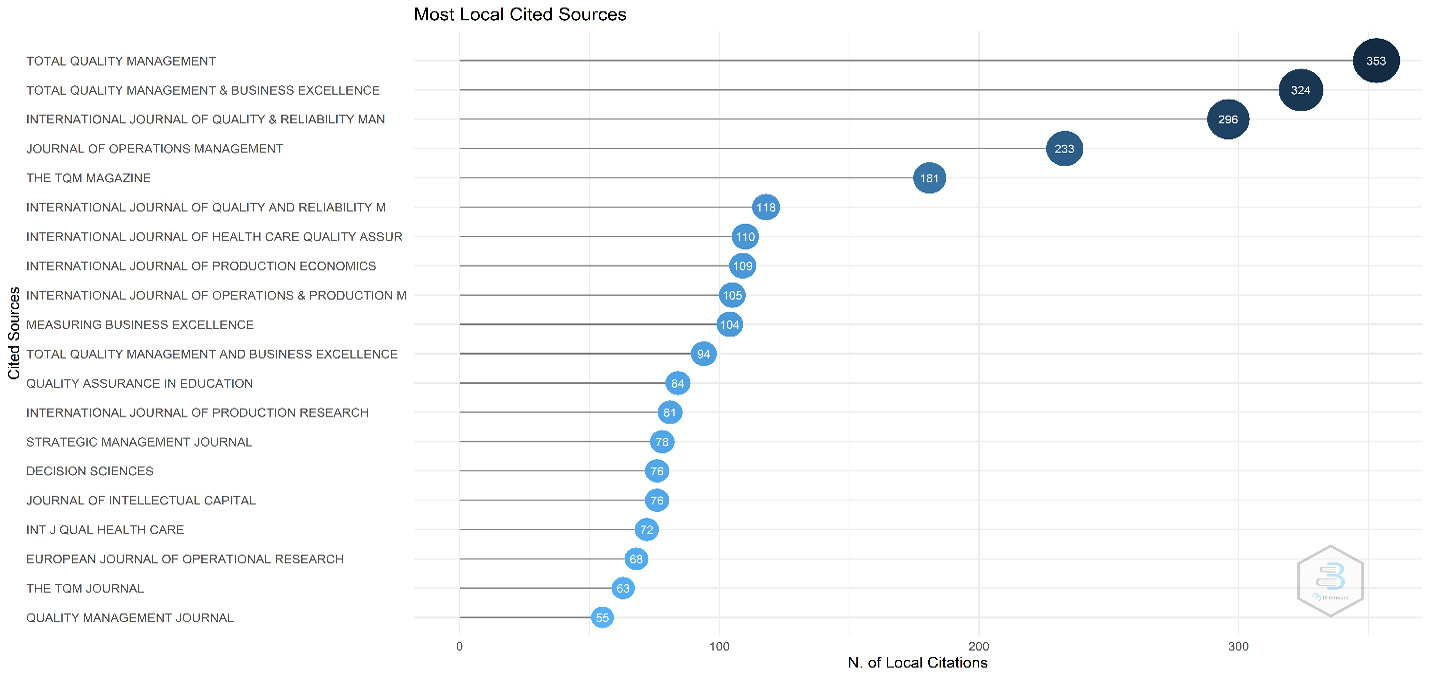
Figure 10
Most local cited sources, database level 2 (TQM in regard to EFQM & Business Excellence). Source: Bibliometric analysis out of R software
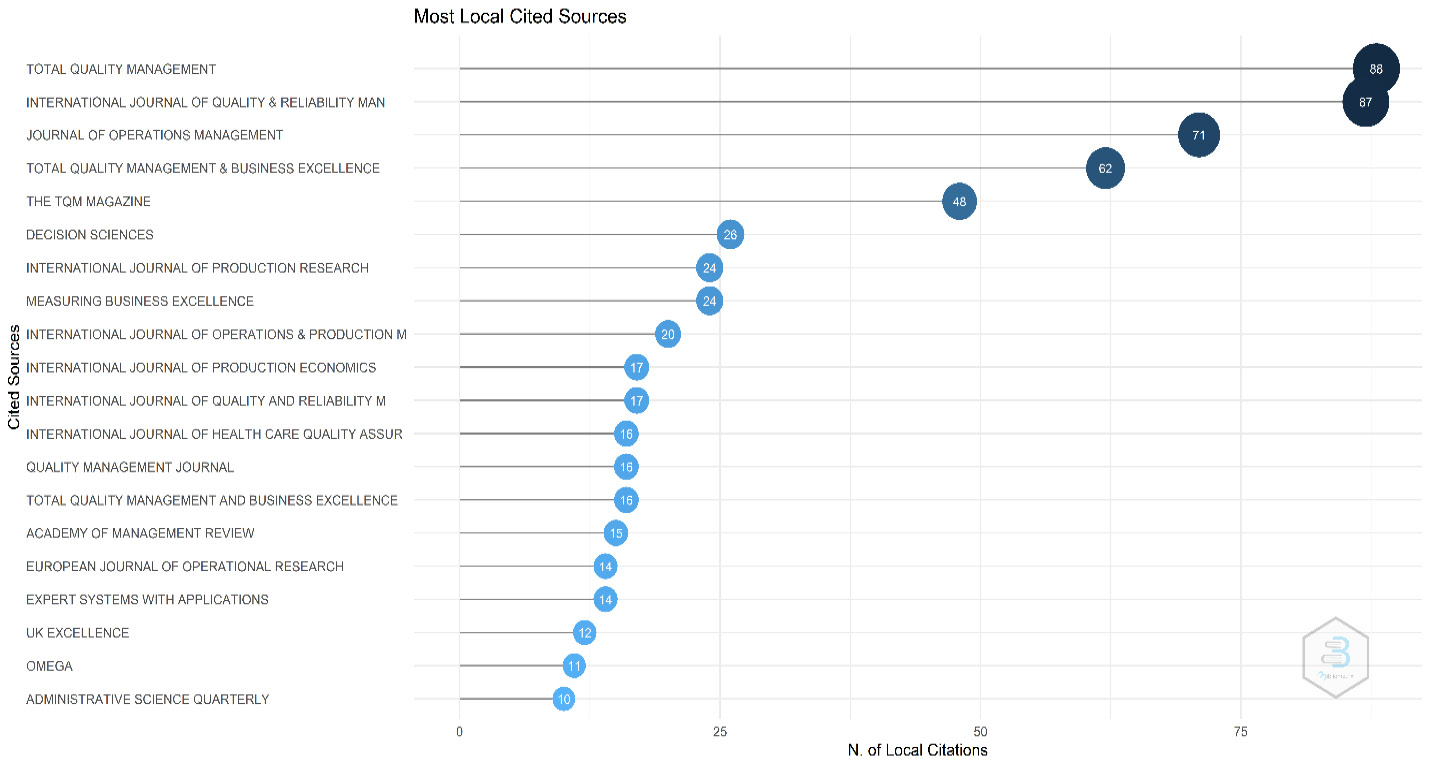
By observing the progress through the years, we can identify that the top 1 source superseded the other sources in 2010 onwards; this can be attributed to EFQM becoming more popular with its internationalization of it, as well as the revision to the model performed at that time (2010). One additional attribute that can be referenced to the high number of documents is that the source is located in the United Kingdom, which was part of the European Union until January 2021.
Figure 11
Source growth, database level 1 (EFQM & Business Excellence). Source: Bibliometric analysis out of R software
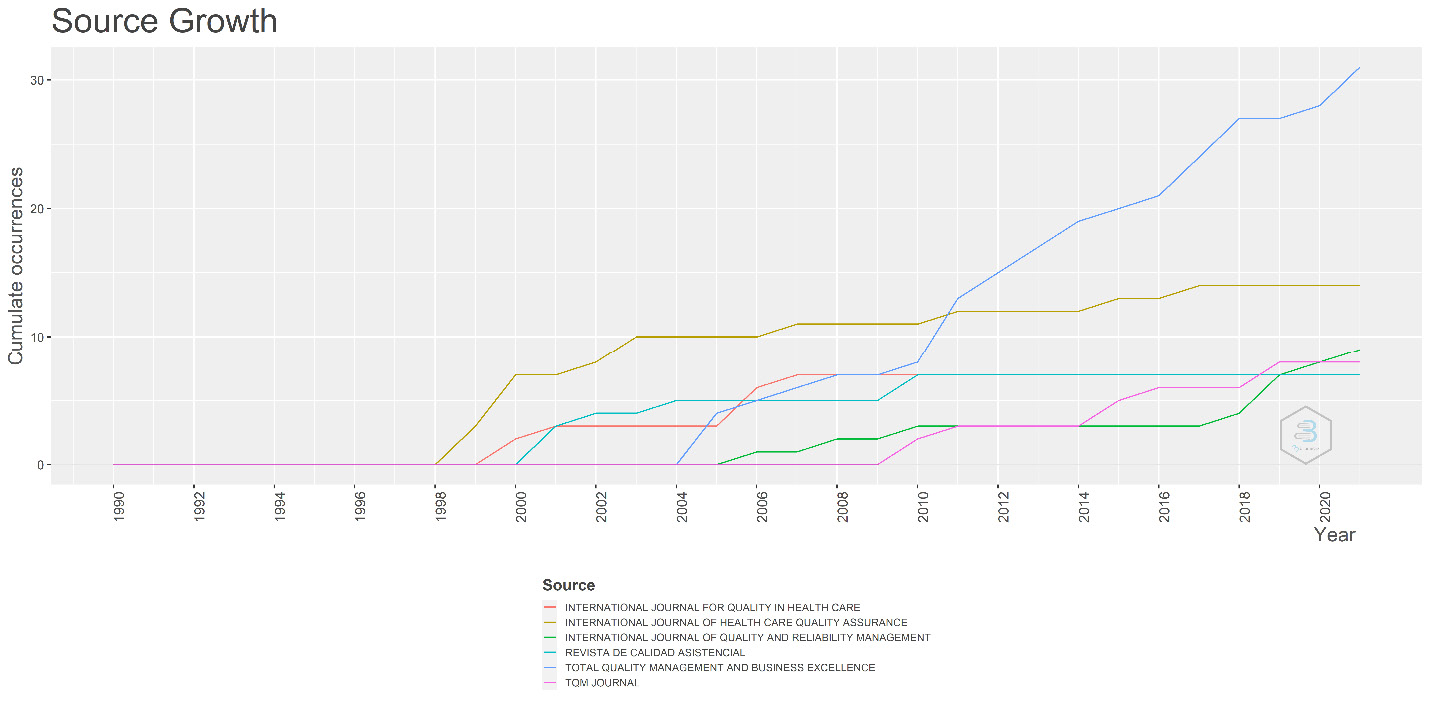
Regarding the most relevant authors, it is identified Calvo-Mora with a total of 10 publications on the subject EFQM and BE, followed by Lagmann and Wedrich with eight publications each. The top 1 behavior is the same observed for the 2nd level database. Calvo-Mora remains in its position with five published documents, which shows the high relation Calvo-Mora identifies between the EFQM model and TQM, as 50% of his published documents adhere to TQM practices to the EFQM model and BE. See Figures 12 and 13 for comparison.
Figure 12
Most relevant authors, database level 1 (EFQM & Business Excellence). Source: Bibliometric analysis out of R software
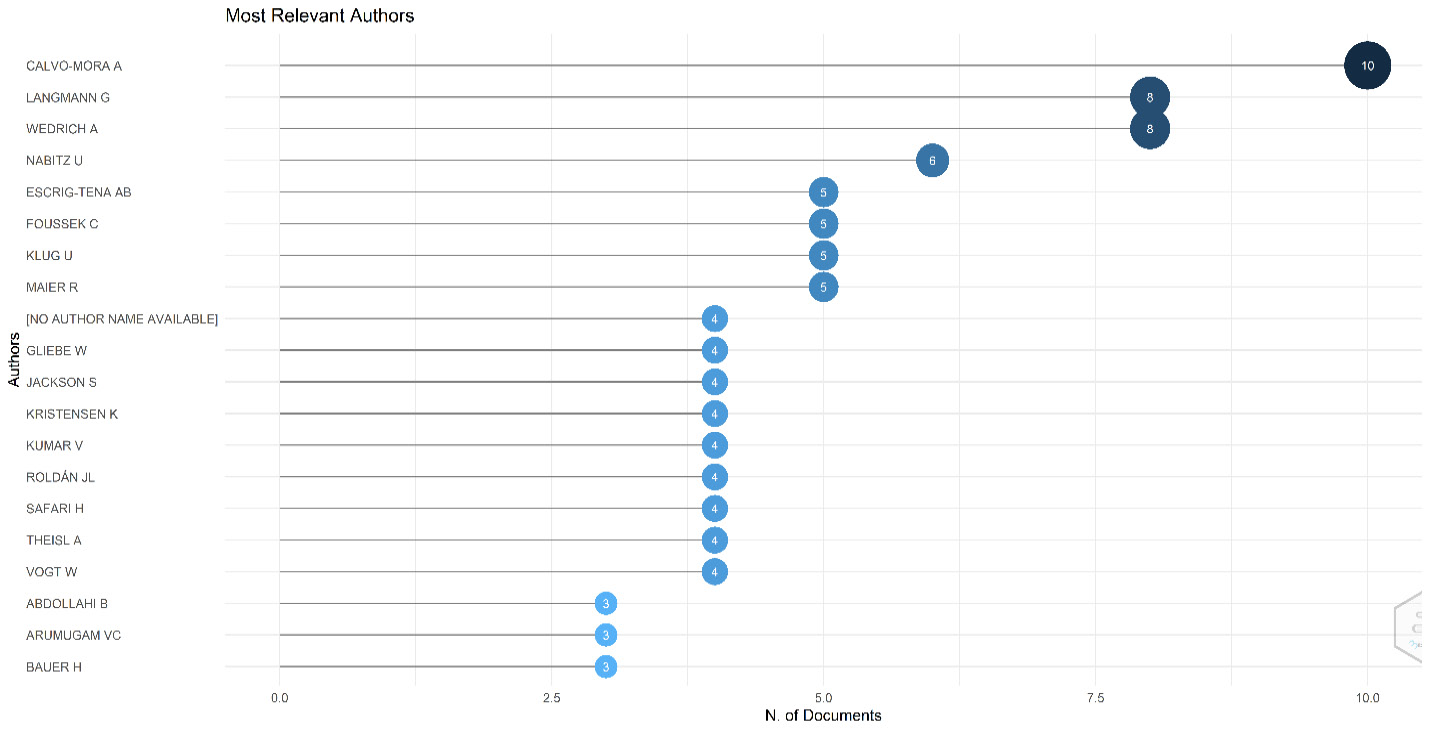
Figure 13
Most relevant authors, database level 2 (TQM in regard to EFQM & Business Excellence). Source: Bibliometric analysis out of R software
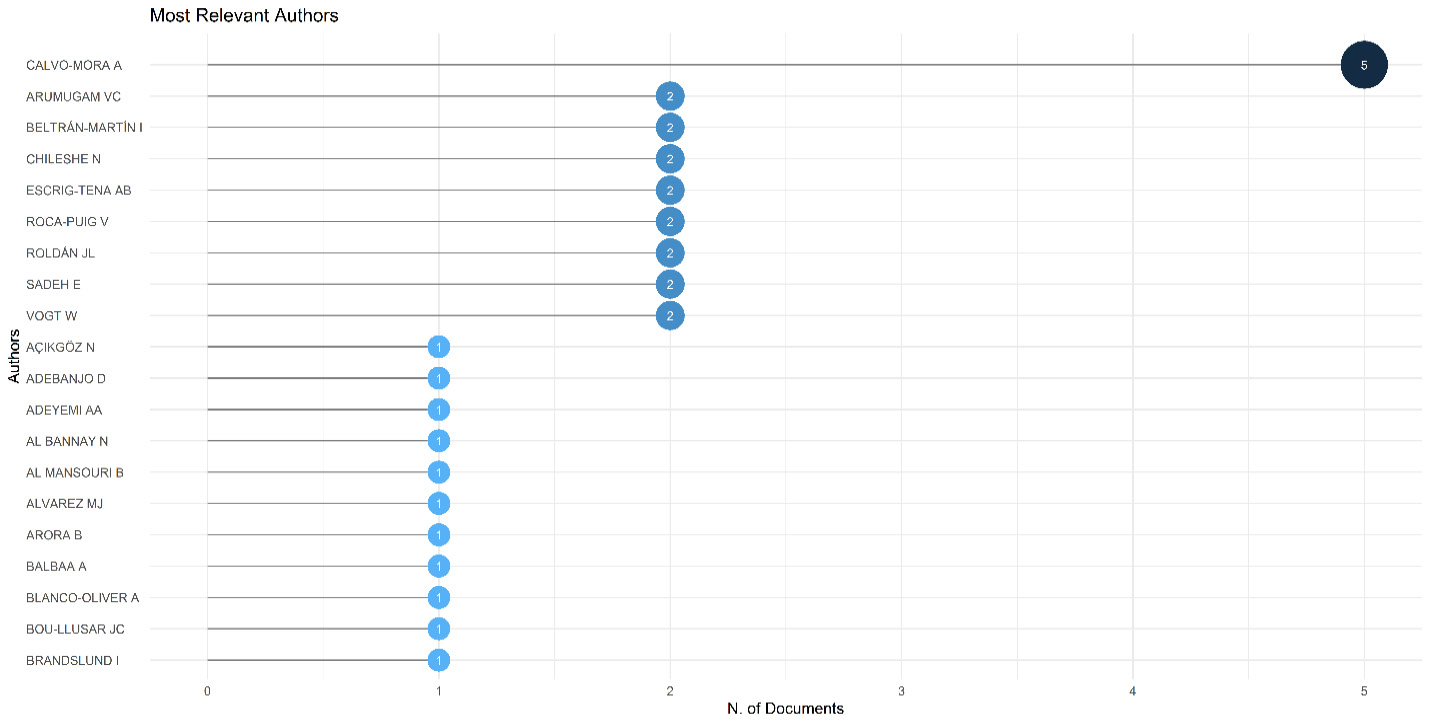
In order to identify the author’s country, the below table is generated. It can be observed that Spanish authors are the ones taking the lead in the publication number of documents. The article’s authors take away the following reflection from the table below.
- No authors from Belgium were found, EFQM was born, and central offices are located there.
- Even though Iran is not part of the European Union, where the EFQM model is popular, Iran is the top 2 country with authors on the subject.
- For the Americas, it only shows the presence of studying the subject by Canadian authors, not other authors found in the top 20 for North, Latin, or South America.
Figure 14
Corresponding author’s country, database level 1 (EFQM & Business Excellence). Source: Bibliometric analysis out of R software
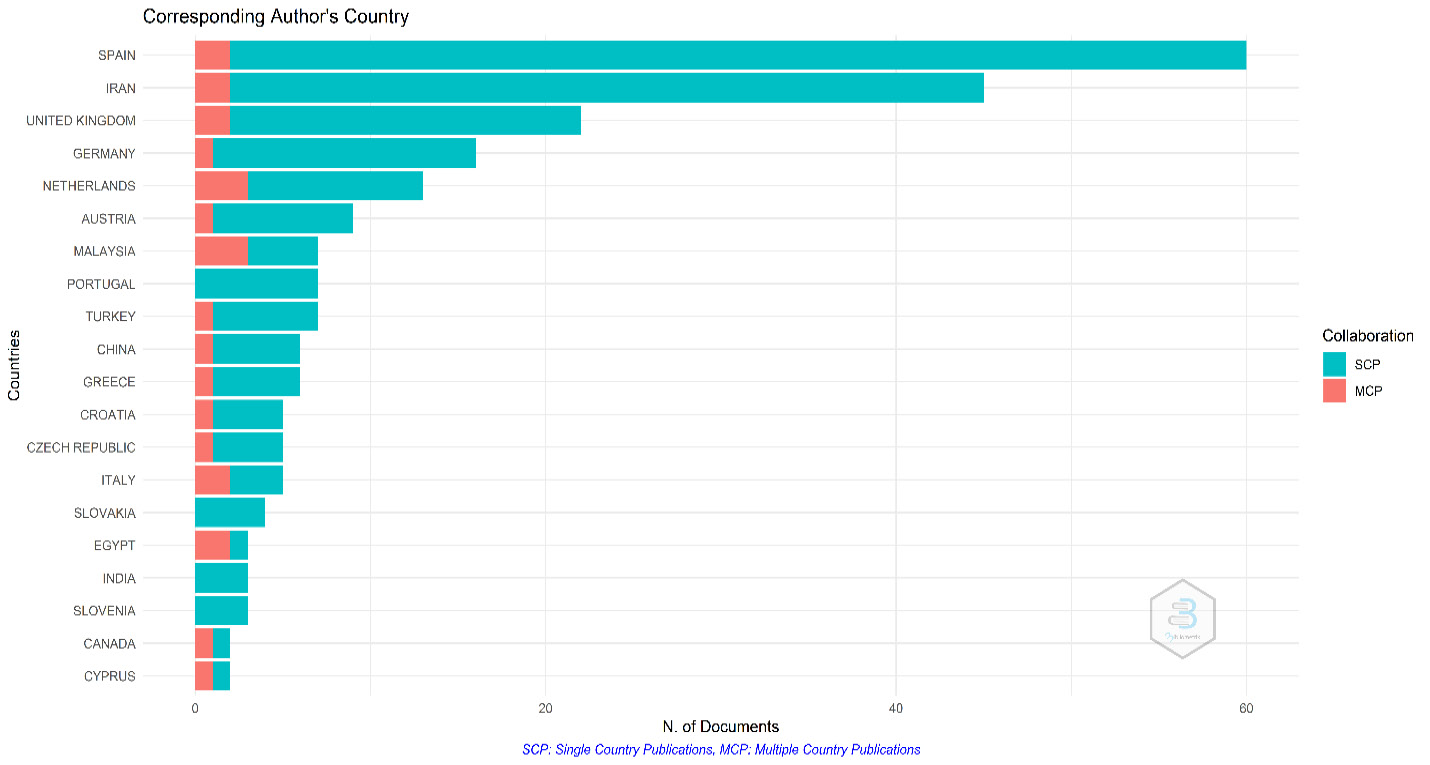
Figure 15
Corresponding author’s country, database level 2 (TQM in regard to EFQM & Business Excellence). Source: Bibliometric analysis out of R software

Figure 15 shows a difference compared to Figure 14. When the concept of TQM was introduced, Spain remained in the top 1. However, Iran is no longer in the table, possibly meaning that research from Iran authors mostly looks at specific cases of study instead of broader cases to include TQM. The authors of this paper further support this notion through their research, which involved additional investigation and filtering of databases. Their findings revealed that approximately 67% of the Iranian authors’ publications focused on specific industries and their applications of the EFQM model. These publications were part of research projects examining the model’s impact.
As seen above, most of the documents published are single-country publications; here is an opportunity for the EFQM model researchers to identify collaboration with other countries; the existing collaboration scheme is shown in the figure below.
Figure 16
Collaboration network by countries, database level 1 (EFQM & Business Excellence). Source: Bibliometric analysis out of R software
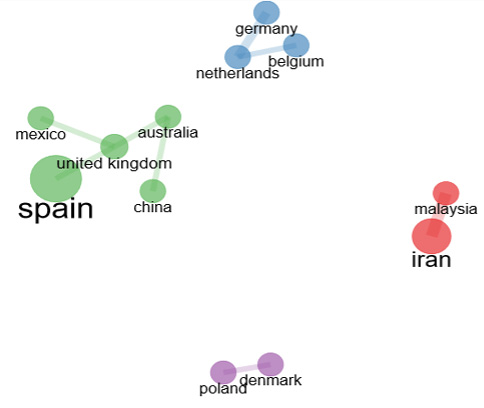
Per the bibliometric analysis result, this paper’s authors have obtained different perspectives on how the EFQM model has been perceived through the years, the level of research performed, and its relation to BE and TQM.
In order to establish a direct relationship between the EFQM model and TQM, the authors propose the following table of concepts and findings as a result of the literature review and bibliometric analysis performed.
Table 1
Comparission between EFQM model 2020 criterions and TQM principles
|
Key topic |
EFQM Model 2020 |
TQM |
|
Strategic Planning |
Purpose, Vision & Strategy |
Strategic and systematic approach |
|
Culture |
Organizational Culture & Leadership |
|
|
Stakeholder requirements |
Engaging Stakeholders |
Customer-focused |
|
Total employee involvement |
||
|
Product & Services |
Creating Sustainable Value |
Process-centered |
|
Integrated system |
||
|
Innovation |
Driving Performance & Transformation |
Continual improvement |
|
Stakeholder satisfaction |
Stakeholder Perceptions |
Customer-focused |
|
Total employee involvement |
||
|
Results |
Strategic & Operational Performance |
Fact-based decision making |
Source: Author’s interpretation based on literature review. Author’s creation.
Per Table 1 above, the paper’s authors showed their interpretation between the EFQM model 2020 and the principles of TQM. The main topics to highlight between the correlation above are the following:
- The EFQM Model 2020 and the TQM principles have a shared focus and different ways of naming some criteria or elements but with a shared perspective of what needs to be addressed to pursue BE.
- The EFQM Model 2020 establishes a strong cause–effect relation between its criteria, meaning that it focuses clearly on the evaluation of Results out of the Direction and Execution perspectives, for example in the Execution perspective, the Engaging Stakeholder criterion is present, and it is evaluated on Results perspective under criterion Stakeholder perceptions. This linkage is not as clear nor strong on the TQM approach.
- The EFQM model 2020 decouples the strategic approach into one perspective called Direction, which contains the criterion’s Purpose, Vision & Strategy, and Organizational Culture & Leadership, while the TQM has a more general approach, less detailed and focused. The Strategic and systematic approach principle from the TQM is similar in content to the EFQM model Direction perspective. However, in the perception from the authors, the TQM needs to be specified on the focus regarding Leadership, which is a key element to developing the organization’s strategy.
- Regarding stakeholders, the EFQM model has a wider scope of stakeholders through the Ecosystem focus, covering different groups of stakeholders such as society, government, partnerships, etc. At the same time, the TQM is mostly oriented only to customers and employees.
4. Conclusions, Research limitations and further research
The present study has some limitations, which indicates avenues for further research. First, the source used was Scopus, as is the one to which the authors can access; additional or different conclusions could be built in the Bibliometric analysis using other databases like Web of Science or Google Scholar. Second, the database used for the bibliometric analysis was layered to start from the concepts of EFQM and BE into TQM; if the layering or filtering is done vice versa or using a different sequencing to sort the three complicated concepts, additional or different results might be observed.
Per Fonseca (2021, p.4), “the EFQM Model is considered valid support for the successful adoption of TQM (Calvo-Mora et al., 2015), adding some new dimensions to the original TQM ones (Gómez et al., 2017). Research results emphasize excellence’s contributions to fostering organizational performance improvement and achieving enduring results (Bendell, 2007; Edgeman, 2018). Empirical evidence points out that its application increases performance in the different areas of the business (financial and non-financial) (Boulter et al., 2013). However, it should be acknowledged that even some organizations regarded as excellent may fail (Dale et al., 2000). Furthermore, new global trends and changes in the business environment (e.g., Industry 4.0) call for a review and update of BEM (Gunasekaran et al., 2019)”.
The EFQM 2020 model is a holistic business model which applies to different sizes and types of organizations. Its validity remains through the years due to its sensitiveness & awareness update in towards current and future streams. It acts towards the need to manage the current situation parallelly to the future transformation while acting to threats and opportunities changing business environments.
During the literature review, other BEMs were identified and overviewed, such as the Baldrige Model, Singapore Quality Award Model, Japan Quality Award Model, Australian Business Excellence Framework, and the Iberoamerican Model, a deeper analysis to include mentioned models would be favorable to continue with this line of research for future papers.
BE models are based on a set of best practices that are established to improve organizational performance and should remain updated to integrate the businesses trends, as the introduction of Industry 4.0, which linkage all the organization to develop a connected environment, digital machines, logistics, storage, and transportation systems, and smart production systems (Elangeswaran et al., 2016).
Per research done, it is concluded that the TQM and the EFQM model pursue the same objective. Both strive for BE; nevertheless, as the EFQM model has evolved through the years, it has a wider scope that is no more dependent on TQM; let us put it this way, when the EFQM model was born, it was based and directly linked to TQM, over the years it evolved integrating streams in which the organization develops, advanced on topics related to leadership and integrated a holistic view of stakeholders and external parties which influence the organization, said this, the EFQM model brings a broader and updated approach to pursuit BE than TQM does.
The contribution of this paper for academics and students is that a similar comparison between TQM and other BEMs could be executed to understand the pros and cons of each, as did with the EFQM model.
Acknowledgments
The author of this paper wishes to thank to the Universidad Popular Autónoma del Estado de Puebla UPAEP, for the opportunity and support given during the generation of this article.